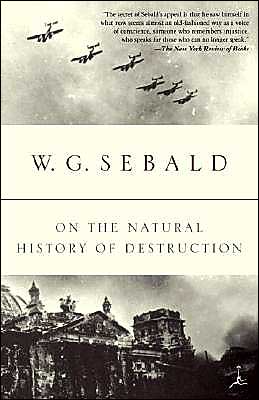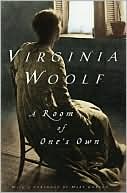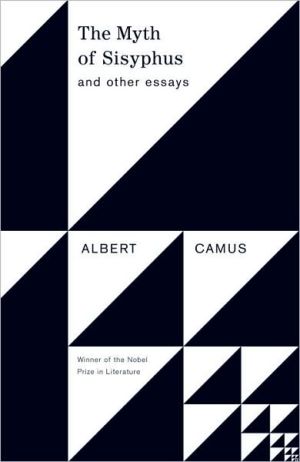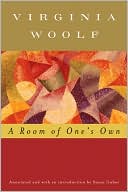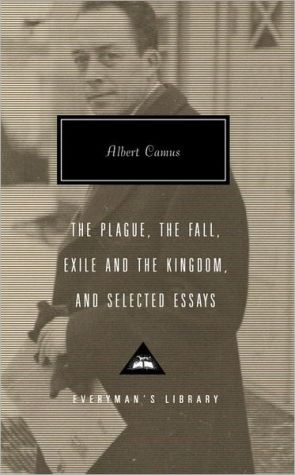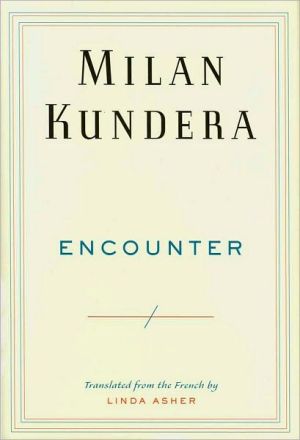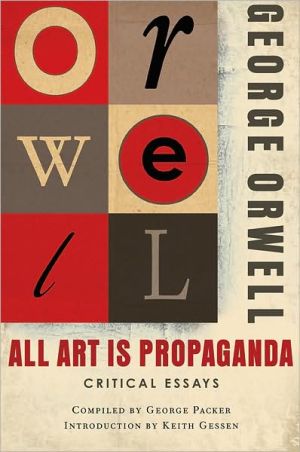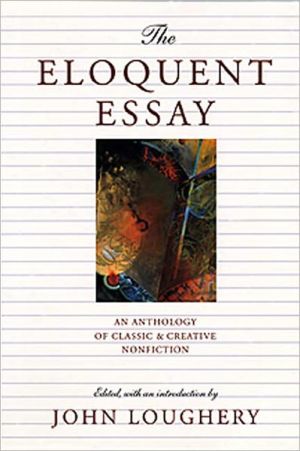On the Natural History of Destruction
During World War Two, 131 German cities and towns were targeted by Allied bombs, a good number almost entirely flattened. Six hundred thousand German civilians died—a figure twice that of all American war casualties. Seven and a half million Germans were left homeless. Given the astonishing scope of the devastation, W. G. Sebald asks, why does the subject occupy so little space in Germany’s cultural memory? On the Natural History of Destruction probes deeply into this ominous silence.
Search in google:
W.G. Sebald completed this extraordinary and important -- and already controversial -- book before his untimely death in December 2001. On the Natural History of Destruction is W.G. Sebald’s harrowing and precise investigation of one of the least examined “silences” of our time.The New York TimesOn the Natural History of Destruction is a complex apologia of a book, one that attempts to absolve a son of the sins of the father by establishing a larger and more generic ground for incrimination. It is a testament, among other things, to the lingering impact of early familial identifications and to the powerful grip of unresolved conflicts between intellectual and emotional allegiances. — Daphne Merkin
Chapter 1\ Air War and Literature Zürich Lectures\ the trick of elimination is every expert's defensive reflex.\ -Stanislaw Lem, Imaginary Magnitude\ I\ Today it is hard to form an even partly adequate idea of the extent of the devastation suffered by the cities of Germany in the last years of the Second World War, still harder to think about the horrors involved in that devastation. It is true that the strategic bombing surveys published by the Allies, together with the records of the Federal German Statistics Office and other official sources, show that the Royal Air Force alone dropped a million tons of bombs on enemy territory; it is true that of the 131 towns and cities attacked, some only once and some repeatedly, many were almost entirely flattened, that about 600,000 German civilians fell victim to the air raids, and that three and a half million homes were destroyed, while at the end of the war seven and a half million people were left homeless, and there were 31.1 cubic meters of rubble for every person in Cologne and 42.8 cubic meters for every inhabitant of Dresden-but we do not grasp what it all actually meant. The destruction, on a scale without historical precedent, entered the annals of the nation, as it set about rebuilding itself, only in the form of vague generalizations. It seems to have left scarcely a trace of pain behind in the collective consciousness, it has been largely obliterated from the retrospective understanding of those affected, and it never played any appreciable part in the discussion of the internal constitution of our country. As Alexander Kluge later confirmed, it never became an experience capable of public decipherment. This is highly paradoxical in view of the large numbers of people exposed to the campaign day after day, month after month, year after year, and the length of time-well into the postwar period-during which they still faced its real consequences, which might have been expected to stifle any positive attitude to life. Despite the enormous efforts whereby some kind of practicable modus vivendi was restored after every attack, even after 1950 wooden crosses still stood on the piles of rubble in towns like Pforzheim, which lost almost one-third of its 60,000 inhabitants in a single raid on the night of February 22, 1945, and no doubt the appalling smells which, as Janet Flanner wrote in March 1947, were released from the yawning cellars of Warsaw by the first warm spring weather pervaded the German cities, too, in the immediate postwar period. But these things obviously did not register on the sensory experience of the survivors still living on the scene of the catastrophe. People walked "down the street and past the dreadful ruins," wrote Alfred Döblin in 1945, after returning from his American exile to southwest Germany, "as if nothing had happened, and . . . the town had always looked like that." The reverse side of such apathy was the declaration of a new beginning, the unquestioning heroism with which people immediately set about the task of clearance and reorganization. A booklet devoted to the city of Worms in 1945-1955 says that "the hour called for upright men of impeccable conduct and aims, almost all of whom would be in the front line of reconstruction for years to come." This booklet, written by one Willi Ruppert for the municipal authorities, included many photographs, including the two pictures of the Kämmererstrasse printed here. They make it look as if the image of total destruction was not the horrifying end of a collective aberration, but something more like the first stage of a brave new world. Writing of a conversation with the directors of I. G. Farben in Frankfurt in April 1945, Robert Thomas Pell records the amazement with which he heard Germans stating their intention of rebuilding their country to be "greater and stronger than ever before"-in a tone in which self-pity, groveling self-justification, a sense of injured innocence, and defiance were curiously intermingled. Nor did they subsequently fail to carry out that intention, as witness the postcards that travelers in Germany can buy today at the newsstands of Frankfurt am Main. From the outset, the now legendary and in some respects genuinely admirable reconstruction of the country after the devastation wrought by Germany's wartime enemies, a reconstruction tantamount to a second liquidation in successive phases of the nation's own past history, prohibited any look backward. It did so through the sheer amount of labor required and the creation of a new, faceless reality, pointing the population exclusively towards the future and enjoining on it silence about the past. German accounts of the time, which is scarcely a generation ago, are so few and far between that Hans Magnus Enzensberger's collection Europa in Trümmern ("Europe in Ruins"), published in 1990, consists predominantly of pieces by foreign journalists and writers making observations that until then had been almost completely ignored in Germany. The few accounts originally written in German are by former exiles or other outsiders, such as Max Frisch. Those who had stayed in Germany and, like Walter von Molo and Frank Thiess in the deplorable controversy over Thomas Mann, were fond of saying that while others were comfortably ensconced in America they themselves had not left their homeland in its hour of need, refrained entirely from commenting on the process and outcome of destruction, probably not least for fear that accurate descriptions might get them into trouble with the occupying forces. Contrary to popular opinion, this shortage of contemporary accounts was not compensated for in postwar German literature which, as it followed a deliberate program of renewal after 1947, might have been expected to cast some light on the real state of affairs. Whilst the old guard of so-called internal emigrants claimed to have been engaged in passive resistance, invoking, as Enzensberger notes, vague notions of freedom and the humanist inheritance of the West in endless and prolix abstractions, the younger generation of writers who had just returned home were so intent on their own wartime experiences, described in a style constantly lapsing into maudlin sentimentality, that they hardly seemed to notice the horrors which, at that time, surrounded them on all sides. Even the frequently cited "literature of the ruins," of its nature presupposing an unerring sense of reality and chiefly concerned, as Heinrich Böll acknowledged, with "what we found when we came home," proves on closer inspection to be an instrument already tuned to individual and collective amnesia, and probably influenced by preconscious self-censorship-a means of obscuring a world that could no longer be presented in comprehensible terms. There was a tacit agreement, equally binding on everyone, that the true state of material and moral ruin in which the country found itself was not to be described. The darkest aspects of the final act of destruction, as experienced by the great majority of the German population, remained under a kind of taboo like a shameful family secret, a secret that perhaps could not even be privately acknowledged. Of all the literary works written at the end of the 1940s, probably only Heinrich Böll's Der Engel schwieg ("The Angel Was Silent") gives some idea of the depths of horror then threatening to overwhelm any who really looked at the ruins around them.9 Reading it, one is immediately aware that this of all novels, a tale which seems marked by irremediable gloom, was more than readers of the time could be expected to take, as Böll's publishers and probably Böll himself thought. As a result it was not published until 1992, almost fifty years later. Indeed, the seventeenth chapter, relating the death throes of Frau Gompertz, is so unremittingly somber that even today it makes painful reading. The dark, stickily clotting blood described in these pages as it pours from the dying woman's mouth in floods and spasms, spreading over her chest, staining the sheets, dripping over the edge of the bed to the floor and forming a glutinous puddle-inky and, as Böll is at pains to emphasize, intensely black-hued blood- symbolizes the despair that militates against the will to survive, the bleak depression that refuses to lift and to which the Germans might have been expected to succumb in view of such a horrific end. Apart from Heinrich Böll, only a few authors-Hermann Kasack, Hans Erich Nossack, Arno Schmidt, and Peter de Mendelssohn-ventured to break the taboo on any mention of the inward and outward destruction, and as we shall see, they generally did so rather equivocally. Even in later years, when local and amateur war historians began documenting the fall of the German cities, their studies did not alter the fact that the images of this horrifying chapter of our history have never really crossed the threshold of the national consciousness. Those compilations, as a rule published by more or less obscure firms-Hans Brunswig's Feuersturm über Hamburg ("Firestorm over Hamburg"), for instance, was issued in 1978 by Motorbuch-Verlag of Stuttgart-often seemed curiously untouched by the subject of their research, and served primarily to sanitize or eliminate a kind of knowledge incompatible with any sense of normality. They did not try to provide a clearer understanding of the extraordinary faculty for self-anesthesia shown by a community that seemed to have emerged from a war of annihilation without any signs of psychological impairment. The almost entire absence of profound disturbance to the inner life of the nation suggests that the new Federal German society relegated the experiences of its own prehistory to the back of its mind and developed an almost perfectly functioning mechanism of repression, one which allowed it to recognize the fact of its own rise from total degradation while disengaging entirely from its stock of emotions, if not actually chalking up as another item to its credit its success in overcoming all tribulations without showing any sign of weakness. Enzensberger points out that it is impossible to understand "the mysterious energy of the Germans . . . if we refuse to realize that they have made a virtue of their deficiencies. Insensibility," he adds, "was the condition of their success." The prerequisites of the German economic miracle were not only the enormous sums invested in the country under the Marshall Plan, the outbreak of the Cold War, and the scrapping of outdated industrial complexes-an operation performed with brutal efficiency by the bomber squadrons-but also something less often acknowledged: the unquestioning work ethic learned in a totalitarian society, the logistical capacity for improvisation shown by an economy under constant threat, experience in the use of "foreign labor forces," and the lifting of the heavy burden of history that went up in flames between 1942 and 1945 along with the centuries-old buildings accommodating homes and businesses in Nuremberg and Cologne, in Frankfurt, Aachen, Brunswick, and Würzburg, a historical burden ultimately regretted by only a few. And in addition to these more or less identifiable factors in the genesis of the economic miracle, there was also a purely immaterial catalyst: the stream of psychic energy that has not dried up to this day, and which has its source in the well-kept secret of the corpses built into the foundations of our state, a secret that bound all Germans together in the postwar years, and indeed still binds them, more closely than any positive goal such as the realization of democracy ever could. Perhaps we ought to remind ourselves of that context now, when the project of creating a greater Europe, a project that has already failed twice, is entering a new phase, and the sphere of influence of the Deutschmark-history has a way of repeating itself-seems to extend almost precisely to the confines of the area occupied by the Wehrmacht in the year 1941.\ The plan for an all-out bombing campaign, which had been supported by groups within the Royal Air Force since 1940, came into effect in February 1942, with the deployment of huge quantities of personnel and war matériel. As far as I know, the question of whether and how it could be strategically or morally justified was never the subject of open debate in Germany after 1945, no doubt mainly because a nation which had murdered and worked to death millions of people in its camps could hardly call on the victorious powers to explain the military and political logic that dictated the destruction of the German cities. It is also possible, as sources like Hans Erich Nossack's account of the destruction of Hamburg indicate, that quite a number of those affected by the air raids, despite their grim but impotent fury in the face of such obvious madness, regarded the great firestorms as a just punishment, even an act of retribution on the part of a higher power with which there could be no dispute. Apart from the reports of the Nazi press and the Reich broadcasting service, which always spoke in the same tone of sadistic terrorist attacks and barbaric gangsters of the air, protests against the long campaign of destruction conducted by the Allies seem to have been few and far between. According to several accounts, the Germans faced the catastrophe that was taking place with silent fascination. "This was not the time," wrote Nossack, "to draw such petty distinctions as the difference between friend and foe." But in contrast to the mainly passive reaction of the Germans to the loss of their cities, which they perceived as an inescapable calamity, the program of destruction was vigorously debated from the first in Great Britain. Not only did Lord Salisbury and George Bell, Bishop of Chichester, repeatedly and very forcefully express the opinion, both in the House of Lords and to the general public, that an attacking strategy directed primarily against the civilian population could not be defended morally or by the laws of war, but the military establishment responsible for conducting the campaign was itself split over this new kind of warfare. The continuing ambivalence in the appraisal of the battle of annihilation was even more pronounced after Germany's unconditional surrender. As accounts and pictures of the effects of area bombing began appearing in England, there was a growing sense of revulsion against damage that had been, so to speak, indiscriminately inflicted. "In the safety of peace," writes Max Hastings, "the bombers' part in the war was one that many politicians and civilians would prefer to forget." Retrospective historical accounts did not clear up the ethical dilemma either. Feuds between various factions were continued in memoirs, and the verdict of historians trying to maintain an objective balance swings between admiration for the organization of such a mighty enterprise, and criticism of the futility and atrocity of an operation mercilessly carried through to the end against the dictates of good sense.\ From the Hardcover edition.
ForewordAir War and Literature: Zurich Lectures1Between the Devil and the Deep Blue Sea: On Alfred Andersch105Against the Irreversible: On Jean Amery143The Remorse of the Heart: On Memory and Cruelty in the Work of Peter Weiss169Notes193
\ From the Publisher“Most writers, even good ones, write of what can be written. . . . The very greatest write of what cannot be written. . . . I think of Akhmatova and Primo Levi, for example, and of W. G. Sebald.” \ —The New York Times\ “[Sebald] is writing about what he regards as a disquieting refusal to face facts—not only about what was done to the nation, but by implication, by the nation. . . . No better future for humankind is possible if we do less than look upon the crimes of our past, and their catastrophic results, with ‘a steadfast gaze.’”\ —The Boston Sunday Globe\ “This may well be the last of Sebald’s writing we’ll ever have, so how amazing—and fitting—it is that it seems, in a fashion as uncanny as his prose and perceptions could often be, to close the circle of the ruminations that preoccupied his writing life.”\ —The Washington Post\ “Sebald approaches his subject with sensitivity, yet avoids neither descriptions of horrible carnage nor criticism of writers too preoccupied with absolving themselves of blame to faithfully portray a destroyed Germany. The result is a balanced explication of devastation and denial, and a beautiful coda for Sebald.”\ —Booklist\ “The secret of Sebald’s appeal is that he saw himself in what now seems almost an old-fashioned way as a voice of conscience, someone who remembers injustice, who speaks for those who can no longer speak.”\ —The New York Review of Books\ \ \ \ \ \ \ The Washington PostIt's hard to miss what he was really saying. Just as Germany was wiederaufgebaut, reconstructed, so Sebald, in this work, reconstructs the reality of what was visited upon Germany. He doesn't do it to give Germans license to say "Look, hey, we suffered too." He does it to remind them of the price they paid for their nation's grievous sin. The silence that was imposed about the firebombing horror is "very understandable," he writes, "if one remembers that the Germans, who had proposed to cleanse and sanitize all Europe, now had to contend with a rising fear that they themselves were the rat people." Yet in Sebald's thinking, facing that reality is the only way to come to terms with it. In that sense, On the Natural History of Destruction is but the final piece of the work of expiation this audacious writer spent his life putting together. Work undertaken, as he confesses in his essay on the playwright Peter Weiss, "in order to set memory to work, since it alone justifies survival in the shadow of a mountain of guilt." — Zofia Smardz\ \ \ The New York TimesOn the Natural History of Destruction is a complex apologia of a book, one that attempts to absolve a son of the sins of the father by establishing a larger and more generic ground for incrimination. It is a testament, among other things, to the lingering impact of early familial identifications and to the powerful grip of unresolved conflicts between intellectual and emotional allegiances. — Daphne Merkin\ \ \ \ \ Publishers WeeklyShortly before his untimely death last year, Sebald had published to great acclaim Austerlitz, the NBCC Prize-winning fourth of his novel-memoirs that appeared in rapid succession. Now comes this slim collection of four essays addressing the same themes that preoccupied Sebald in Austerlitz and his other major works-memory and survival in an era marked by so much wanton cruelty. The four essays gathered here find Sebald turning his luminous intelligence and rich, sometimes caustic prose on major figures of postwar German literature. Sebald can be a devastating critic: he dislikes melodrama and falsehood, is inspired by crisp, serious prose and veracity. In essays on Alfred Andersch, Jean Amery and Peter Weiss, Sebald suggests that great writing is underpinned by moral fortitude. In "Air War and Literature," Sebald criticizes the silence of postwar German literature on the starvation, mutilations and killings caused by Allied bombings. The essay provoked a major controversy when it appeared in Germany in 1999. Some commentators were dismayed that Sebald chose to revisit those difficult times and to attack, with his full ironic and sardonic powers, a number of revered figures in German literature. Sebald was dismayed that his comments provoked an outpouring of support from those who could talk only about German suffering and Jewish conspiracies. But only at the very end, almost as an afterthought, does Sebald place this suffering in historical context, as the consequence of German policies of total war and the Holocaust. "Air War and Literature" is an important but flawed effort by a writer who always demanded unflinching engagement with the past. B&w photos. (On sale Feb. 11) Copyright 2002 Cahners Business Information.\ \ \ \ \ Library JournalAuthor of the best-selling Austerlitz (winner of the National Book Critics Circle Award), Sebald died in 2001 before he could approve this felicitous translation of his Zurich lectures on the literature of the air war waged on Germany by the Allies and its destructive impact on the German population. Added to this English-language edition (already excerpted in The New Yorker) are three essays on German writers of the destruction, Karl Amery, Alfred Andersch, and Peter Weiss. Central to all of these essays is a meditation not on literary expression but on silence and its meanings. Especially in the Zurich lectures, Sebald considers the devastation of Germany and asks why writers were for so long silent, or equivocal, on this topic, as if to write at all about the bombings would be seen as claiming victimhood. These essays complement Sebald's major work but are secondary to it, though it is likely that the closely reasoned and limpid Zurich lectures will continue to be cited and read by specialists for years to come. Academic libraries aiming for completeness should include this volume; smaller or more general collections can represent this stream of thought with Austerlitz and with Primo Levi's If Not Now, When? [Previewed in Prepub Alert, LJ 10/1/02.]-Barbara Walden, Univ. of Wisconsin, Madison Copyright 2003 Cahners Business Information.\ \ \ \ \ Kirkus ReviewsInterconnected essays from the recently deceased German novelist (Austerlitz, 2001, etc.) on his nation’s capacity to cause, absorb, and forget suffering. "In spite of strenuous efforts to come to terms with the past," writes Sebald, "it seems to me that we Germans today are a nation strikingly blind to history and lacking in tradition." Born in 1944 in a corner of the Alps comparatively untouched by the war, his mental landscape was nonetheless populated by the ruins and corpses of the Hitler era. In the first portion of this text, he examines the Allied bombing campaigns that virtually leveled Germany’s cities and towns but—as the Allied commanders well knew, he asserts—did little damage to the Nazi war-making capability; it was punishment for its own sake. Though hundreds of thousands of civilians died, Sebald writes, the destruction "seems to have left scarcely a trace of pain behind in the collective consciousness, it has largely been obliterated from the retrospective understanding of those affected, and it never played any appreciable part in the discussion of the internal constitution of our country." Sebald lucidly depicts the suffering of his people even as he wonders why contemporaries are unwilling to discuss it. He ventures no apology or claim to victim status; as he carefully notes, "The majority of Germans today know, or so at least it is to be hoped, that we actually provoked the annihilation of the cities in which we once lived." The second half considers the careers of several German writers whose work examines (or fails to examine) the horror of the time. Readers with a background in modern German literature will be at an advantage in following Sebald’s arguments,though this is not a prerequisite to understanding his glum conclusion that literature is essentially powerless in the face of evil. Somber and moving: a contribution to the literature of WWII from a perspective that will be new to most American readers.\ \
